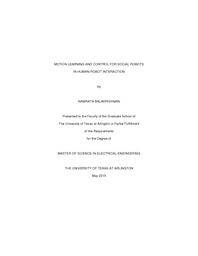
ATTENTION: The works hosted here are being migrated to a new repository that will consolidate resources, improve discoverability, and better show UTA's research impact on the global community. We will update authors as the migration progresses. Please see MavMatrix for more information.
Show simple item record
| dc.contributor.author | Balakrishnan, Namrata | en_US |
| dc.date.accessioned | 2015-07-31T22:10:20Z | |
| dc.date.available | 2015-07-31T22:10:20Z | |
| dc.date.submitted | January 2015 | en_US |
| dc.identifier.other | DISS-13184 | en_US |
| dc.identifier.uri | http://hdl.handle.net/10106/25120 | |
| dc.description.abstract | In the domain of social robotics, robots have recently been used in conversational interaction with humans. In this thesis, research was conducted to help create a system for imitation learning. In this system, a trainer trains a robot to be a teacher. The robotic teacher interacts with other humans in order to teach them the task that the robot was trained on. The method of `Teaching by Demonstration' was used, where an ideal motion is performed by a trainer. This ideal motion is learned by the robot and replayed in the subsequent interaction with humans. If the replayed motion is copied by the human, the closeness of the motion performed by the human and the robot are compared. The task is then repeated until the desired optimal motion (as performed by the trainer) is obtained from the human subject. The main focus of the thesis is to define a general imitation system that can encode different motions which are beneficial in social robotics. A technique called Dynamic Movement Primitives (DMPs) was selected as the method for recording and generating the generalized robotic motions. The human-robot interaction gestures are compared using another algorithm called Dynamic Time Warping (DTW) and the validity of DTW as a comparison metric was also studied.DMPs are a set of non-linear differential equations which are used as the framework for describing human motion in a generalizable manner. A motion can be expressed as a combination of the learnt movement primitives. The DMPs have the flexibility to encode any motion into a set of differential equations by just adjusting certain parameters. The task/ motion that the robot is to teach a human subject is learnt using the DMPs. Once the motion is taught to the human, the gesture performed by the human and the motion of the robot are juxtaposed and analyzed using the DTW method. DTW is an algorithm which analyzes motion series that change temporally. Similarities between the gestures performed by the robot and the imitation done by the human are studied using DTW. Trials are performed to validate the utility of DTW as an effective measure for comparison. | en_US |
| dc.description.sponsorship | Popa, Dan | en_US |
| dc.language.iso | en | en_US |
| dc.publisher | Electrical Engineering | en_US |
| dc.title | Motion Learning And Control For Social Robots In Human-robot Interaction | en_US |
| dc.type | M.S. | en_US |
| dc.contributor.committeeChair | Popa, Dan | en_US |
| dc.degree.department | Electrical Engineering | en_US |
| dc.degree.discipline | Electrical Engineering | en_US |
| dc.degree.grantor | University of Texas at Arlington | en_US |
| dc.degree.level | masters | en_US |
| dc.degree.name | M.S. | en_US |
Files in this item
- Name:
- Balakrishnan_uta_2502M_13184.pdf
- Size:
- 1.883Mb
- Format:
- PDF
This item appears in the following Collection(s)
Show simple item record


